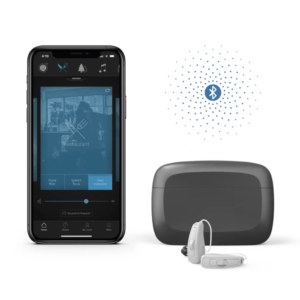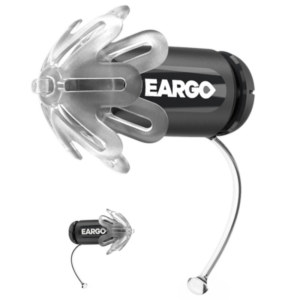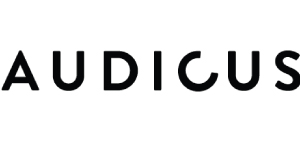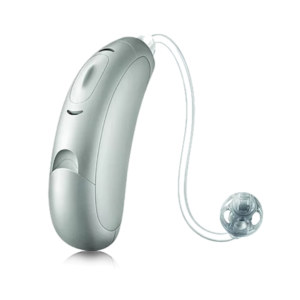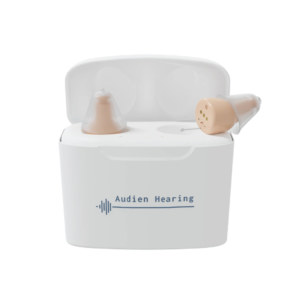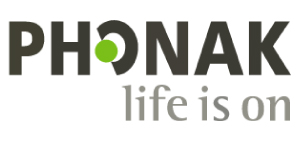Best Hearing Aids of 2023
AgingInPlace.org keeps our resources free by working as an affiliate partner with some companies mentioned on our site. These partnerships or the commission we may earn do not affect our opinions or evaluations of the products we mention. Our reviews are solely based on our research methodology and from input from our AgingInPlace.org Advisory Board. Learn more about our ad policies.
Best Hearing Aids of 2023
Products carousel
If you’re experiencing hearing loss, you’re not alone: Roughly 430 million Americans also have difficulty hearing. Hearing loss is especially common among older adults, with more than half of all older adults above 75 experiencing various degrees of hearing loss. While there’s no cure, hearing aids are often highly customizable and can help treat hearing loss while improving your overall quality of life.
“Wearing hearing aids also allows for greater independence and safety,” said Hillary Taylor, Au.D., vice president of Audiology for Livingston Hearing Aid Center. “The earlier a person can treat their hearing loss with hearing aids, the better because untreated hearing loss over time can increase the risk for cognitive decline and decrease the amount of benefit received from hearing aids.”
Sadly, fewer than 30% of people aged 70 and older who need hearing aids use them, according to the National Institute on Deafness and Other Communication Disorders. In an AgingInPlace.org survey of 1,000 hearing aid users, more than 52% of respondents indicated that cost was the No. 1 reason why they were hesitant to get hearing aids. Fortunately, the FDA ruling in October 2022 allowing over-the-counter (OTC) hearing aid sales has improved public access and helped lower the financial burden.

Depending on your level of hearing loss, prescription hearing aids might be the better option, but if you experience mild to moderate hearing loss, OTC hearing aids may work for you. The bottom line is that getting older doesn’t mean you have to give up engaging in your community or hearing the sounds you love. To help you find the right hearing solution for you, we interviewed experts and researched, purchased, and tested 15 well-known hearing aid brands to come up with the top 10 picks for the best hearing aids of 2023.
Best Hearing Aids Based on Research and Testing
Over-the-Counter Hearing Aids
- Editor’s Choice: Jabra Enhance Select 200
- Best Invisible Hearing Aid: Eargo 6
- Best for Ongoing Care: Audicus Omni
- Best Budget Option: Audien Atom Pro
- Best Value: MDHearing VOLT MAX
Prescription Hearing Aids
- Best for Severe Hearing Loss: Phonak Naida Paradise
- Audiologist’s Pick: Starkey Evolv AI
- Best for Tinnitus: ReSound ONE
- Best High-Tech Features: Widex MOMENT
- Best for Active Lifestyles: Signia Active Pro
Why You Can Trust Our Expert Review
Best Hearing Aids of 2023
Formerly Lively 2 Pro
- Price: $1,995 per pair
- Features: Receiver in canal, Bluetooth streaming, telecoil, tinnitus management, rechargeable battery, three-year warranty, 100-day free trial, financing available
- Hearing Loss Level Treated: Mild to moderate
- How to Purchase: Online
Pros
-
Affordable Bluetooth-audio-streaming hearing aid
-
Longer free trial than other brands
Cons
-
Requires a hearing test and audiology consult
-
Cleaning and app usability are not the easiest
Editor’s Choice
What Is Editor’s Choice?
Our team of editors and writers choose a product from each article that stands out based on our extensive research of the products we review. While it may not always be the highest-scoring product in the lineup, we’ve chosen the product based on its overall value to our audience.
Why We Chose This Product:
The Jabra Enhance Select 200 (formerly Lively 2 Pro) strikes the best balance between features and affordability by offering features typical of high-end hearing aids in a less expensive direct-to-consumer option.
With high-end hearing aid features at an affordable price, Enhance Select 200 is our highest-scoring hearing aid and Editor’s Choice for best hearing aid. The Enhance Select 200 packs in full features of Bluetooth hearing aids. It can connect to Apple and some Android smartphones with the Enhance Select mobile app and act as wireless headphones to stream audio from your phone or TV and take hands-free phone calls. You can also use your smartphone to switch between Enhance Select 200’s listening programs, which are preset combinations of hearing aid settings that optimize hearing aid function in places with different noise levels, like restaurants and the outdoors. Plus, you can control hearing aid volume and select which devices to stream audio from through your smartphone. The Enhance Select 200’s features are comparable to those of the more expensive Bluetooth hearing aids but at half the cost.
The Enhance Select 200 is a receiver-in-canal hearing aid. With this style of hearing aid, the receiver that amplifies sound goes directly in the ear canal instead of behind the ear in the hearing aid’s hard shell like similar behind-the-ear hearing aids. The Enhance Select 200 offers a tinnitus management feature that generates sounds to temporarily relieve tinnitus, or ringing in the ears. Other features include a telecoil, a water-resistant hard shell, a rechargeable battery with a life of 24 hours, a three-year warranty, and a generous 100-day free trial—the longest of any trial offered by other brands. With Jabra Enhance Select hearing aids you are required to complete a hearing test and an online consult with one of the company’s audiologists before making a purchase.
When we purchased the Enhance Select 200, we first took the 10-minute online hearing test and discussed our results with a Jabra Enhance audiology team member before placing our order. The hearing aids we received in the mail were programmed based on our specific test results. Jabra Enhance also gives you the option to upload an audiogram if you’ve already been tested by an audiologist at an in-person clinic. After purchase, Jabra Enhance continues to offer remote access to their audiology care team for fine-tuning your hearing aid settings and updating the software that runs them.
Direct-to-consumer hearing aids with remote hearing care help make hearing aids more affordable while giving you access to audiologists when you need them.
Overall, we gave the Enhance Select 200 a 4.27/5 rating. Compared to all other hearing aids we tested, the Enhance Select 200 outscored the rest on customer support, earning a nearly perfect score for good phone support, financing options, a fast response time and having excellent instructions on how to use the hearing aids. It took only 10 seconds through the Jabra Enhance Select app for a customer representative to respond to our request for assistance. Our favorite added touch from Jabra Enhance: The brand prints its setup instructions in larger print to make them easier for older adults to read. The Enhance Select 200 lost some points with us, however, because cleaning the hearing aids and using the app wasn’t as easy as some other brands, like Widex and Audicus. The BBB seems to agree with our overall Jabra Enhance impression—it gives Jabra Enhance an A+ rating and its customer reviews score Jabra Enhance at 4.33/5 stars. If you have mild to moderate hearing loss and want more affordable hearing aids that offer a long free trial and don’t sacrifice tech features, the Enhance Select 200 may be the choice for you.
In November 2022, Lively rebranded to Jabra Enhance following GN Group’s acquisition of Lively in 2021 to expand offerings in the telehealth market. Lively’s existing hearing aid technology will continue to be offered, but now as Jabra Enhance Select 50, Enhance Select 100, and Enhance Select 200.
- Prices: $2,950 per pair
- Features: Invisible style, Bluetooth connectivity, rechargeable battery, two-year warranty, 45-day free trial, financing available
- Type of Hearing Loss Treated: Mild to moderate
- How to Purchase: Online
- Headquarters: U.S.
Pros
-
A rechargeable invisible hearing aid that’s over the counter
-
Easy-to-use app with responsive customer service
Cons
-
Small size makes it more difficult to clean
-
No audio streaming
The smallest in-canal hearing aid on the market, Eargo 6 gets our vote for best invisible hearing aid. Of all invisible Eargo hearing aids, the Eargo 6 packs the most impressive sound technology into the most discreet hearing aid that’s smaller than the diameter of a quarter and can’t be seen when worn. Invisible hearing aids, unlike receiver-in-canal and behind-the-ear hearing aids, fit completely inside the ear with no hard shell that rests behind the ear.
Because of its small size, the Eargo 6 can’t support Bluetooth streaming for use as wireless headphones, but it does have Bluetooth app connectivity like the VOLT MAX. The Eargo 6 has an app feature, Sound Match, that tailors your volume and pitch preferences for each ear based on a hearing screening you complete on the app. It’s the only Eargo hearing aid to feature their most advanced sound feature, Sound Adjust, that more precisely and automatically eliminates non-speech background frequencies to better enhance speech. Other Eargo 6 features include a rechargeable battery with a 16-hour battery life, a two-year warranty, and a 45-day free trial. The Eargo 6 is also water resistant.
Eargo offers an online hearing test, or you can submit an audiogram taken at a hearing clinic. Although testing isn’t required to purchase your hearing aids—unless you’re planning to use medical insurance to pay for them—Eargo’s customer representative recommended we take the brand´s hearing test and then speak with one of its “personal hearing guides” (not audiologists, but rather people Eargo trains to understand the type of hearing loss the company´s hearing aids treat) about the results to ensure the Eargo 6 is a good fit.
The Eargo 6 received a rating of 3.81/5 stars from us. It scored well for durability. It didn’t show any signs of damage after putting it through our 10-trial drop test and water dunk test to verify its water resistance. Like MDHearing, we also found Eargo’s app easy to use—we had no problems connecting our Eargo 6 hearing aids to the app and only waited one minute to connect to customer service on the app, and less than one minute for responses to our questions. The customer representative was able to adequately explain how our charger’s indicator lights worked.
Because of its small size, we found the Eargo 6 difficult to clean, especially when removing ear tips, and we would not recommend the model to someone who has difficulty with hand dexterity.
Eargo is BBB-accredited with an A- rating and a 3.62/5 stars rating from BBB customer reviews. Trustpilot customer reviews rate it higher with 4.5/5 stars. If you’re self-conscious about wearing a hearing aid and like the idea of the Bluetooth app connectivity feature, Eargo 6 is a more affordable invisible hearing aid that hides your hearing loss.
- Prices: $2,998 per pair ($159 per month with the Audicus Plus plan after a $499 sign-up fee)
- Features: Receiver in canal, telecoil, tinnitus masking rechargeable battery, Bluetooth streaming, leasing option available, two-year warranty, 45-day free trial, no financing options
- Hearing Loss Level Treated: Mild to moderately severe
- How to Purchase: Online
Pros
-
Offers a hearing aid rental option
-
One of the easiest hearing aids to connect to its app
Cons
-
Less clear how to contact customer service on the app
The Omni, most high-tech Bluetooth hearing aids by Audicus, are our “Best for Ongoing Care” because of Audicus’ unique hearing aid membership program that lets you rent a hearing aid model for 18 months. The Audicus membership program charges a monthly fee, and you become eligible for an upgrade to a newer model if you renew your 18-month contract. For the Audicus Omni, the monthly rental fee costs $129 per month, and there is an additional one-time sign-up fee of $499. As part of the rental plan, you receive free cleanings, an unlimited warranty and damage protection, and replacement of lost devices for a $250 fee. Audicus also offers the option to buy its hearing aids outright at $2,998 per pair with the disposable battery option, or for an additional $400, you can purchase the rechargeable option for $3,398 per pair.
The Audicus Omni is a receiver-in-canal hearing aid that offers Bluetooth audio streaming, hands-free calling, and remote programming from audiologists when software updates and assistance with changing hearing aid settings are needed. The Audicus Omni’s app is compatible with both Apple and Android smartphones. Telecoil and tinnitus masking features can also be added to these hearing aids. The Audicus Omni is water resistant and comes with a rechargeable battery with a 16-hour battery life.
Audicus offers a free online hearing test before purchase or the option to upload a test from a hearing clinic. We rated the Audicus Omni with 3.97/5 stars and were especially impressed by its ease of use and good durability—it had the fewest steps to follow when connecting to the app. Also, the hands-free calling feature automatically initiated without us having to push any buttons on the phone or the hearing aids. Connecting with customer service on the app, however, was a less clear process. Instead of using a recognizable name like “Audicus” or “Omni,” the app takes you to “Unitron” when you want to contact customer service. Audicus is BBB-accredited, with a BBB rating of A+ and a score of 3.08/5 stars based on customer reviews. The Audicus Omni is a good option for people who want regular, free upgrades to the newest hearing aid model and other perks that come with the company´s membership plan.
- Prices: $249 per pair
- Features: In-the-canal, rechargeable battery, one-year warranty, 45-day free trial, no financing options
- Hearing Loss Level Treated: Mild to moderate
- How to Purchase: Online
- Headquarters: U.S.
Pros
-
Relatively inexpensive
-
OTC hearing aids with an easy online purchasing process
Cons
-
No Bluetooth technology for connection to other devices
-
Instruction manual is bare
The Audien Atom Pro doesn’t have the technology of other models we reviewed, and its cost reflects that, making it a good, basic hearing aid for the budget-conscious who prioritize price and basic sound amplification over extra features. The Audien Atom Pro is a discreet in-the-canal hearing aid that has a rechargeable battery with a 24-hour battery life. These hearing aids do not have Bluetooth capabilities or telecoil, and they are not water resistant.
We’ve rated the Audien Atom Pro with 3.49/5 stars. In order to change the volume on your Atom Pros, you have to push a tiny screw on the back of each hearing aid. We found this to be easy but not as convenient as using an app to change the volume. We also noticed there’s no off switch, so if you’re not using the hearing aids, you have to put them in their charger or the batteries will drain. The hearing aids also have no alert to remind you the battery is getting low.
We also weren’t impressed with the relatively bare instruction manual. In order to get full instructions, you have to be able to watch YouTube videos online. However, despite the low price, we found the Atom Pro durable. It survived our 10-trial drop test without a scratch. Its ear tips, however, seemed fragile, like they could rip when we changed them. Despite the simplicity of its hearing aids, Audien has good customer reviews on the BBB website with a 3.97/5-star customer rating and a BBB accreditation with a score of B. Trustpilot customer reviews rate Audien with 3.4/5 stars.
- Prices: $699.98 per pair
- Features: Behind the ear, Bluetooth connectivity, rechargeable battery, one-year warranty, 45-day free trial, financing available
- Hearing Loss Level Treated: Mild to moderately severe
- How to Purchase: Online
- Headquarters: U.S.
Pros
-
Affordable Bluetooth-app-connectivity hearing aid
-
Can be purchased without a prescription
Cons
-
No audio streaming
-
Short battery life
MDHearing VOLT MAX hearing aids are our “Best for Bluetooth Connectivity” because they allow you to change hearing aid settings like volume and listening programs and receive remote assistance from audiologists. However, you cannot use these hearing aids as wireless headphones to stream audio or take hands-free phone calls. VOLT MAX’s smartphone app is compatible with Apple and Android phones and also lets you monitor the hearing aids’ battery life.
MDHearing VOLT MAX is a behind-the-ear hearing aid that appears similar to Jabra Enhance Select’s receiver-in-canal style, except its receiver is in the hard shell behind the ear instead of inside the ear canal when worn. In addition to Bluetooth connectivity, VOLT MAX’s features include a rechargeable battery with a 15-hour battery life, a 45-day free trial, and a 90-day warranty. It is not water resistant.
We gave MDHearing VOLT MAX 3.10/5 stars, with high marks for its smartphone app that’s easy to use. We were able to download VOLT MAX’s app in under 20 seconds, and the hearing aids were able to automatically connect to the app. MDHearing VOLT MAX lost some points because of longer customer service wait times on its app—we had an approximate 3-minute wait before receiving a request for us to leave our number so they could call us back. Other companies like Jabra Enhance and Eargo responded within a minute or less. On BBB, customer reviews rate MDHearing with 4.21/5 stars.
Doesn’t provide the most responsive customer support and its VOLT MAX hearing aids aren’t as technologically advanced as other hearing aids, but if you have mild to moderately severe hearing loss and want a basic behind-the-ear hearing aid with Bluetooth app connectivity, VOLT MAX offers you these features without breaking the bank.
- Prices: $3,000–$7,000 (retailer dependent)
- Features: Receiver-in-canal style, telecoil, rechargeable and disposable battery options, Bluetooth streaming, up to a three-year warranty, up to a 60-day free trial, financing is retailer dependent
- Hearing Loss Level Treated: Mild to Profound
- How to Purchase: Through an audiologist
Pros
-
Advanced streaming technology and sound quality
-
Best-value hearing aid when comparing advanced features and pricing
Cons
-
More easily damaged than other hearing aids in our drop test
-
A separate accessory is needed for advanced streaming technology
The Phonak Naida Paradise is a receiver-in-canal hearing aid that we voted best for severe hearing loss because it has the option to pair with a remote microphone system that allows for direct audio streaming into the hearing aids with RogerDirect technology that’s more advanced than Bluetooth. RogerDirect technology can adapt to varying noise levels and speech coming from different directions and filter background noise and amplify speech better than typical microphone systems of other hearing aid brands that use Bluetooth. The Phonak Naida Paradise comes with built-in RogerDirect technology, but you have to buy its compatible microphone separately.
The Phonak Naida Paradise comes in two slightly different models: one with a disposable battery and the other with a rechargeable battery that has a 24-hour battery life. Only the disposable-battery version comes with telecoil. The Phonak Naida Paradise uses Bluetooth for connecting to Apple and Android smartphones to stream audio, take hands-free phone calls, and make hearing aid adjustments. These hearing aids are waterproof. Warranties and free trial periods will vary by the retailer you purchase them from, but warranties can be as long as three years and free trial periods as long as 60 days.
We gave the Phonak Naida Paradise 3.54/5 stars. Of all the hearing aids we tested, it received the best value score based on its price for the features, warranty, and free trials offered. We also rated it well for being easy to clean and having an easy-to-use app. It lost some points in our 10-trial drop test for showing signs of damage, such as cracks forming at the base of the hearing aid, about halfway through the trials.
Phonak is BBB accredited with an A+ rating but has a 2.33/5-star rating. Trustpilot shows a 2/5-star rating based on customer reviews. Some users poorly rated Phonak the company, not the Phonak Naida Paradise hearing aids, citing an unhelpful technical support staff and difficulty staying connected to the smartphone app. Customers do say, however, that Phonak’s sound quality is excellent. The Phonak Naida Paradise treats mild to profound hearing loss. These hearing aids are a good option for anyone with more severe hearing loss who is willing to invest in high-quality tech features.
- Prices: $2,800–$7,500 per pair (retailer dependent)
- Features: Six hearing aid styles, Bluetooth streaming, telecoil, tinnitus masking, rechargeable and disposable battery options, one- to three-year warranty, 30-day free trial, financing is retailer dependent
- Hearing Loss Level Treated: Mild to profound hearing loss
- How to Purchase: Through an audiologist
- Headquarters: U.S.
Pros
-
Fall detection and medication reminder features
-
Caregiver app for monitoring your safety and activity levels
Cons
-
Bluetooth connectivity issues when pairing app and hearing aids during testing
Advanced technology that increases safety is the reason prescription hearing aid Starkey Evolv AI is our audiologist’s pick. The Starkey Evolve AI is the only hearing aid we reviewed to come with the impressive features of fall detection and a caregiver app that alerts your loved ones.
“I have a lot of patients whose kids use this app, primarily to detect when their parent falls or to ensure they’re wearing the hearing aids,” Rachel Magann Faivre, Au.D., an audiologist and owner of Oklahoma City-based ASH Audiology, said about the Thrive app. “Even though many of these patients also wear a life alert necklace, [assisted] living facility staff sometimes aren’t quick to respond to those. The Thrive Care app allows the family to call a facility immediately upon a fall. Also, a patient may think they’re wearing their hearing aids, but don’t have them turned on or charged. The app is also helpful for family to see and troubleshoot. To my knowledge, Starkey is the only company that offers this. It’s so useful for my patients.”
Keep in mind, however, that unlike a medical alert system, fall detection with Starkey Evolv AI does not call an emergency response center; it only sends an alert to your selected contacts to let them know you’ve fallen.
The Starkey Evolv AI comes in six different styles: behind the ear, receiver in the canal, in the ear, in the canal, completely in the canal, and invisible. Starkey hearing aids act as wireless headphones, streaming audio and allowing hands-free calls with Apple and Android devices via Bluetooth. The Thrive Hearing Control app has features for tinnitus masking, locating misplaced hearing aids, and setting medication and appointment reminders. You can also use the app to create customized listening programs for places you frequently visit that the hearing aids will remember so you don’t have to manually switch to them when you need them. The Starkey Evolv AI is water resistant and comes in disposable and rechargeable battery versions. Rechargeable battery life lasts up to 24 hours on a single charge.
The Evolv AI received 3.81/5 stars from us. We found the app to be easy to use and to have plenty of options for tweaking sound preferences. We liked that you could access the user guide and operations manual directly from the app. Unfortunately, we experienced connection issues with pairing the hearing aids to the app and got disconnected from Bluetooth during our testing. We found the Evolv AI to be durable—it withstood our drop and dunk tests without any visible signs of damage. Starkey is a BBB-accredited company with an A+ rating. On Trustpilot, it has a rating of 3.1/5 stars from customer reviews with some complaints similar to ours about connecting to Bluetooth. For families who like the fall detection and care apps that let you monitor your loved one’s activities, there’s no other hearing aid that quite compares to the Starkey Evolv AI for its monitoring and safety features.
- Prices: $2,800–$7,500 per pair (retailer dependent)
- Features: Receiver in the ear, Bluetooth streaming, telecoil, tinnitus masking, rechargeable and disposable battery options, four-year warranty, 30-day free trial
- Hearing Loss Level Treated: Mild to severe
- How to Purchase: Through an audiologist
Pros
-
Many app features for managing tinnitus
-
App is easy-to-follow once connected
Cons
-
Difficult to connect hearing aids to the app
-
Instruction manual is difficult to follow
Compared to the other hearing aids we reviewed, prescription hearing aids ReSound ONE put an added emphasis on treating tinnitus with its ReSound Relief app that includes sound therapy, relaxing exercises, and meditation videos to help mask tinnitus symptoms. Tinnitus is the perception of a sound, usually a ringing in the ears, that a person hears because of damage to the ear. The ReSound Relief app has 35 masking sounds to choose from, such as ocean and forest sounds, to distract you from tinnitus.
The app also lets you keep track of how often and when you’re using the feature so you can discuss your symptoms with your audiologist who can help you tweak and adjust how you’re treating your tinnitus. The app is compatible with both Apple and Android smartphones, and even the basic free plan offers plenty of functionality, according to Hadassah Kupfer, Au.D . For $6.99 per month or $69.99 per year, you can purchase ReSound’s Relief Premium plan that offers personalized training plans to manage tinnitus. As part of the plan, you’ll gain access to more in-depth meditations that include education on breathing and imagery.
The ReSound ONE is the first hearing aid model to have a microphone attached to the hearing aid receiver in the ear canal, making it a microphone and receiver-in-canal hearing aid. This style is meant to improve sound quality and your ability to recognize where sound is coming from. The ReSound ONE also has telecoil and Bluetooth capabilities for audio streaming, hands-free calling, remote programming, and adjusting hearing aid settings through the smartphone. The ReSound ONE is water resistant. Its two versions include a disposable battery option and a rechargeable battery option. The rechargeable battery option has a battery life of 25-30 hours on a single charge, depending on how often you use audio streaming.
We rated ReSound ONE with 3.65/5 stars. Unfortunately, during our testing, it took us several tries before we successfully connected to and set up the app, totaling at least 15 minutes. The app was easy to use for controlling ReSound hearing aid settings and clearly marked each setting, such as treble, bass, mic boost and TV streaming. The ReSound ONE’s buttons for controlling volume and switching between listening programs were more difficult to use because they required more precision to push than those of other hearing aids we tested. It came with four instruction manuals, which we found difficult to follow due to the amount of information they contained.
The company ReSound has a Consumer Affairs rating of 3.2/5 stars, a BBB rating of F, and has 1/5 stars from the BBB’s customer reviews. Because of its focus on tinnitus, the ReSound ONE is a good option for anyone with hearing loss who wants the added in-depth tinnitus management features.
- Prices: $2,800–$7,500 per pair (retailer dependent)
- Features: Prescription, three hearing aid styles, Bluetooth streaming, telecoil, tinnitus masking, rechargeable battery, three-year warranty, 45-day free trial, financing is retailer dependent
- Hearing Loss Level Treated: Mild to profound
- How to Purchase: Through an audiologist
Pros
-
Shorter sound processing delay than other hearing aids for clearer, more natural sound
-
Fastest connection time between hearing aids and app
Cons
-
Difficult-to-follow instruction manual
-
No way to contact customer service through the app
The Widex MOMENT has advanced sound technology that gives users more customization options than other hearing aids and allows the MOMENT to adapt to different sound environments more automatically. The MOMENT processes sounds faster than other hearing aids because of a very short sound processing delay, which also makes it less likely to distort sounds and better able to mimic our natural hearing abilities. It can automatically switch between different listening programs to amplify speech when noise levels vary in different situations so you don’t have to manually do it yourself.
Widex offers the MOMENT in three styles: behind-the-ear, receiver-in-canal, and completely-in-canal. It is Bluetooth compatible with Apple and Android smartphones for audio streaming, hands-free calling, and remote visits with an audiologist, and changes to hearing aid settings through the smartphone app. Other features include telecoil and tinnitus masking. Receiver-in-canal and behind-the-ear models come in disposable or rechargeable battery versions. Receiver-in-canal rechargeable hearing aids have an estimated battery life of 16 hours; behind-the-ear rechargeable hearing aids have a battery life up to 37 hours, but closer to 24 hours if frequently using audio streaming. The MOMENT is also water resistant.
We gave the Widex MOMENT 3.71/5 stars. It earned a perfect score for its quality and variety of tech features along with how easy it was to use its app. MOMENT hearing aids connected to the app via Bluetooth in less than a minute, faster than any other hearing aid we tested. The app included many details for customizing the MOMENT using clear, easy-to-digest language and formatting.
We thought the print in the instruction manuals, however, was too small, and also the language was somewhat hard to follow. We also disliked that you can’t contact customer service directly through the Widex app. If you need assistance, you have to contact your audiologist’s office instead of the manufacturer’s customer service team like with a lot of the other hearing aids we tested. On Consumer Affairs, Widex as a company has a customer review rating of 3.7/5 stars. If you’re willing to spend more on high-quality prescription hearing aids that can treat up to profound hearing loss, the Widex MOMENT´s sound technology can’t be beat.
- Prices: $2,898–$4,598 per pair (retailer dependent)
- Features: Prescription, in the canal, Bluetooth streaming, tinnitus masking, rechargeable battery, three-year warranty, 45-day free trial, financing is retailer dependent
- Hearing Loss Level Treated: Mild to severe
- How to Purchase: Through an audiologist
Pros
-
Sporty look so it doesn’t look like a hearing aid
-
Good wind reduction for clearer sound outdoors
-
Stays in place during exercise
Cons
-
Requires the purchase of an accessory to connect to Android phones
-
Difficult-to-understand instruction manual
Endorsed by triathletes with hearing loss, the Signia Active Pro lives up to its name. Similar in appearance to earbuds, the durable and water-resistant in-the-canal Active Pro hearing aids stay in place while exercising. Athletes also praise this Signia hearing aid for having good wind reduction, which means it reduces how loud wind sounds through the hearing aid, so you get less interference from wind and can focus on hearing other sounds. Active Pro uses Signia Xperience sound technology that’s meant to help the active wearer in a busy environment be aware of sounds from all directions.
The Signia Active Pro has a tinnitus masking feature and Bluetooth capabilities for audio streaming, hands-free phone calls, remote programming from an audiologist, and connection to Signia’s app for changing hearing aid settings. The Active Pro is a “made for iPhone” (MFI) hearing aid, which means it can only connect directly to Apple smartphones. It connects to Android devices only with the purchase of a separate device known as the Signia Streamline Mic. Streamers enable incompatible devices to connect via Bluetooth. The Active Pro comes with a rechargeable battery that lasts 26 hours on a single charge. To save battery and make life more convenient for the active user, the Active Pro automatically shuts off when placed in its charger and automatically turns back on when removed from the charger and placed in the ear.
The Signia Active Pro received 3.70/5 stars from us. We found the setup instructions to be more technical and difficult to understand. Connecting to Signia’s app for the first time, however, was quick and easy. Another plus we noticed when inquiring about the Active Pro’s hearing settings was that customer service was very thorough in their explanations.
Signia the company was rated well by customers on Consumer Affairs, 4/5 stars.
The Signia Active Pro is an excellent choice if you’re athletic, wanting to wear your hearing aids while working out, and willing to spend more on the high-quality technology of prescription hearing aids.
What Is a Hearing Aid?
A hearing aid is a medical electronic device worn in or behind the ear to improve hearing by amplifying sounds. These devices can treat mild to severe hearing loss.
Today’s hearing aids use digital technology in a computer chip. A microphone built into the hearing aid receives and converts sounds into electrical signals. An amplifier then makes the electrical signal louder and transmits it to a receiver, or speaker, that produces the amplified sound in the ear for the brain to eventually interpret.
Difference Between a Hearing Aid and PSAP
Because hearing aids are medical devices, they are regulated by the FDA. Other products called personal sound amplification products (PSAPs) also amplify sounds but are not regulated by the FDA because they are considered electronic, not medical devices. PSAP manufacturers don’t have to follow regulations that ensure these products won’t damage your hearing. These devices are meant for people with normal hearing who want to amplify sounds for specific activities, such as hunting or birdwatching.
Over-the-Counter Hearing Aids
To make hearing aids more affordable and accessible, the FDA finalized its rules in August 2022 for allowing over-the-counter (OTC) hearing aids to be sold in stores. Before then, hearing aids couldn’t be sold in stores unless they required you to see an audiologist and take a hearing test first. OTC hearing aids are available only for adults age 18 and older with mild to moderate hearing loss based on their own perception of how severe they think their hearing loss is. OTC hearing aids are still considered medical devices, and their manufacturers have to follow FDA regulations, although these regulations are less strict than those for prescription hearing aids.
Difference Between OTC and Prescription Hearing Aids
OTC hearing aids don’t require a hearing test or prescription from an audiologist to purchase and can be bought online directly from the manufacturer or in a store.
Prescription hearing aids require a hearing test and consultation with an audiologist before purchase and treat more severe hearing loss than OTC hearing aids. They are the only hearing aid option available to anyone younger than age 18. Prescription hearing aids are more expensive than OTC hearing aids because they have more sophisticated technology that requires programming from an audiologist to treat more severe hearing loss, and they also include professional services related to customizing the fitting and ensuring the best medical outcome with the chosen equipment.
How To Know if You Need a Hearing Aid
Age-related hearing loss can occur gradually and may be noticed by your family and friends before you notice it. Some common signs and symptoms include:
- Trouble hearing people when they speak, especially in noisy settings
- Asking others to repeat themselves or speak more slowly
- Tinnitus, or ringing in the ears
- Turning up the TV volume more than usual
- Having more difficulty understanding women and children because they speak at higher pitches
- Difficulty hearing chirping birds or beeping devices
If you’re experiencing these symptoms, you can complete a hearing test to confirm your hearing loss and tell you what type of hearing loss you have. The most accurate testing will come from a test conducted by an audiologist. However, many online hearing aid manufacturers offer hearing tests on their websites as a starting point.
How to Choose the Right Hearing Aid
To choose the right hearing aids, you need to make sure they fit comfortably in your ears and improve your hearing. Here are four steps to take to find hearing aids that are right for you:
- Schedule an appointment with an audiologist to complete a professional hearing test that tells you what type of hearing loss you have and how severe it is. An audiologist can then make specific recommendations on hearing aids to match your hearing loss and let you try out different hearing aid styles.
- Consider how hearing aids feel when wearing them. Hearing aids come in different styles that can provide different levels of comfort when in your ears. If you’re very particular about how well a hearing aid fits in your canal, you may be better off getting a prescription custom-fit hearing aid that’s shaped based on a mold of your ears. OTC hearing aids with a variety of ear tips to switch between can increase your chances of finding a comfortable fit that still amplifies sounds in a way that improves your hearing.
- Note the length of your hair. Sheri Mello, Au.D, with Raleigh Hearing and Tinnitus Center told us that people with long hair typically don’t like the feeling of their hair brushing against and getting snagged on bulkier hearing aid models. She tries to fit her patients who have long hair with in-the-ear hearing aids to avoid this source of discomfort.
- Factor in your lifestyle, including when you’re likely to use your hearing aids. If you have an active lifestyle, smaller hearing aids that are sweat resistant may be your best option. If you love watching television, hearing aids with Bluetooth audio streaming will enhance audio quality. In our AgingInPlace.org hearing aid user focus group, we learned that people who regularly wear masks have trouble with behind-the-ear hearing aids because of their mask straps getting caught on them.
How an Audiologist Helps a Person Decide Which Hearing Aids Are Right for Them
We interviewed Mello during our Hearing Aid Summit. She provided the following list of questions you should ask yourself when shopping for hearing aids:
- What is my budget?
- Is financing available for my hearing aid?
- Are the hearing aids I’m interested in FDA approved?
- What are other customers saying about sound quality and feedback from the hearing aid?
- Do I prefer to control my hearing aids’ volume by pressing buttons on the hearing aid or by using a smartphone app?
- What is the hearing aids’ reputation for minimizing background noise?
Hearing Aid Features to Consider
- Bluetooth capabilities: Hearing aids with Bluetooth capabilities can connect to smartphones so you can use your phone to control hearing aid settings like volume and switch between listening programs. Hearing aids with Bluetooth vary in their Bluetooth technology. Some have only Bluetooth connectivity, which means they can only connect to smartphones. Others have Bluetooth streaming, which means they can be used as a pair of wireless headphones that directly stream audio from your smartphone and TV to improve sound quality with these activities.
- Rechargeable battery: Many hearing aid models now offer only rechargeable battery options, although some still make versions that have disposable batteries. Hearing aids with rechargeable batteries may be preferred over disposable batteries because you won’t have to worry about how difficult it is to open the battery compartment and replace them. Rechargeable hearing aids vary greatly in the number of hours they run before needing to be recharged. Some run for as little as 15 hours, while others can run over 35 hours on a single charge. If you plan to use Bluetooth often, which drains the battery faster, you’re better off with a hearing aid that has a longer battery life.
- Feedback suppression: Hearing aid feedback is an annoying whistling sound that occurs when sounds that should be going from the hearing aid’s microphone into the ear canal bounce back to the microphone and get amplified again. Feedback suppression, also called feedback cancellation, is technology that lets hearing aids identify feedback and cancel out these sounds before you hear them.
- Directional microphones: Directional microphones allow hearing aids to better detect and enhance speech sounds while reducing levels of background noise. This improves your ability to hear a person speaking to you in a noisy environment.
- Tinnitus masking: Tinnitus is a ringing in the ears or similar sound you hear when no such sound is being produced in the environment. It’s a common symptom of hearing loss. Tinnitus can become less noticeable when you introduce other sounds into the ear that compete for your brain’s attention. Hearing aids that have a tinnitus-masking feature play white noise or soothing sounds, like the sound of a stream, in moments when you’re experiencing tinnitus so that you notice it less.
- Telecoil: Telecoil, or T-coil, is a technology that predates Bluetooth and allows hearing aids to wirelessly connect to telecoil-enabled phones and sound systems in public venues that have inductive loops, a type of assistive listening system for people with hearing loss. Hearing aids that have a telecoil have a small coil of wire inside of them that picks up electromagnetic signals for wireless connection. A telecoil greatly improves sound quality by allowing audio to be streamed directly into the hearing aid and is most often used for streaming sound in public venues like churches and movie theaters.
Types of Hearing Aids
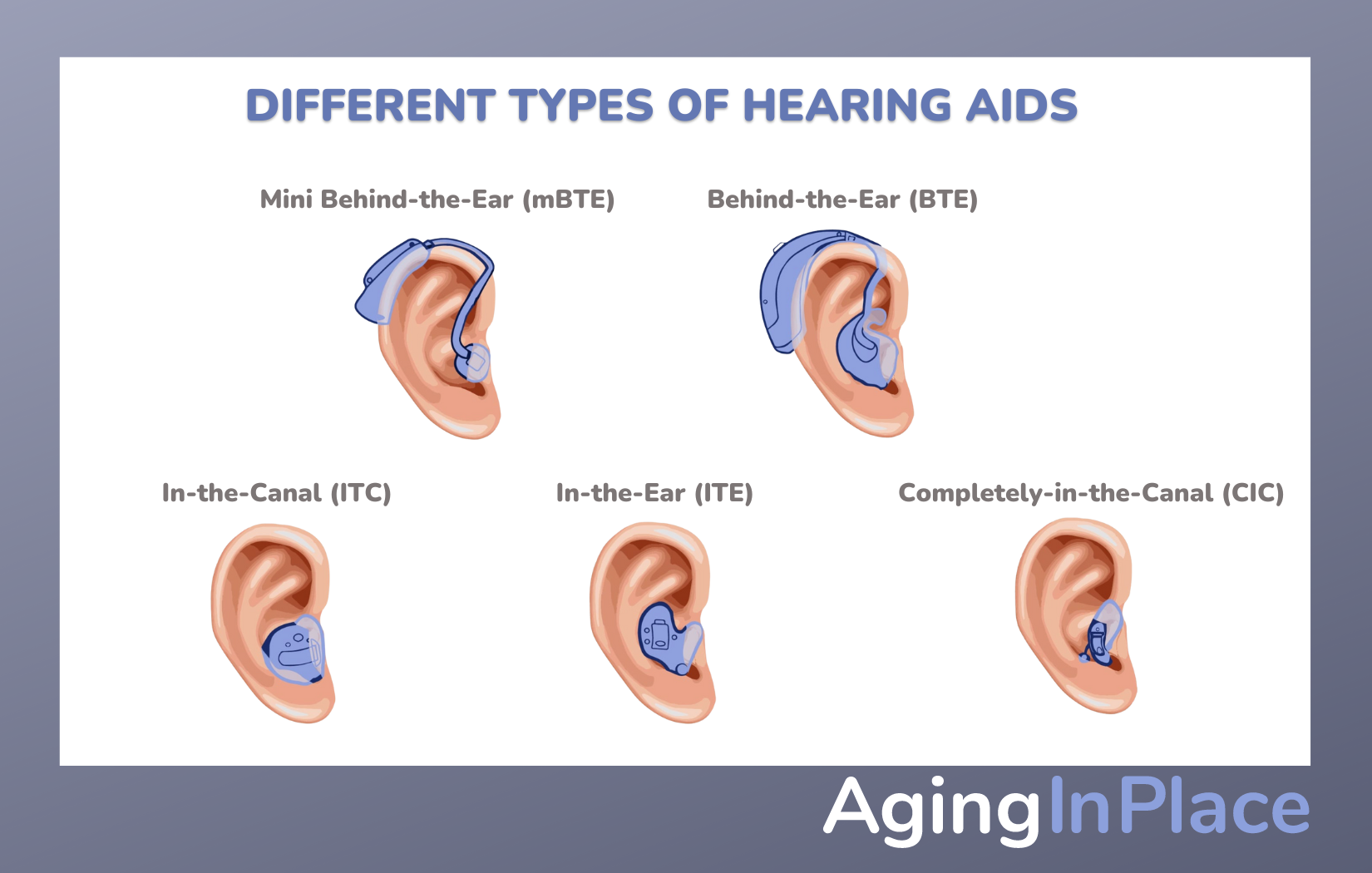
Behind-the-Ear (BTE) Hearing Aids
BTE hearing aids sit behind your ear and have a plastic tube that loops over the top of your outer ear. That tube connects to an earpiece that sits in front of the ear canal. The piece behind your ear, known as the hard shell, holds the hearing aid technology—the microphone, amplifier, speaker, battery, and, when included, the T-coil. BTE devices can treat more severe hearing loss because they’re capable of more amplification than other styles, are easy to repair, are generally comfortable, and have room to hold more advanced technology. They’re also less likely to have feedback and whistling than in-the-ear (ITE) hearing aids. BTE devices are not as discreet as ITE hearing aids and can irritate the back of your ear, especially if you wear glasses.
Mini Behind-the-Ear (mBTE) Hearing Aids
Mini BTE hearing aids, also known as receiver-in-canal hearing aids, are similar in appearance to BTE hearing aids but have a slimmer hard shell and a receiver that sits in the ear canal at the end of the plastic tube instead of in the hard shell like with the BTE. Smaller wires of the mBTE that fit in the ear are meant to reduce the sensation of a clogged ear canal that can accompany the BTE models. A drawback of mBTE hearing aids is that they don’t amplify low frequencies as well as some other hearing aid styles and, therefore, may not be the best option for severe hearing loss.
Traditional in-the-ear (ITE) Hearing Aid
The hard shell of ITE hearing aids sits completely inside of the outer ear instead of behind the ear like with BTE hearing aids. ITE hearing aids are custom-fit to your outer ear shape and size. They are capable of Bluetooth streaming and telecoil and can treat mild to severe hearing loss. ITE hearing aids are the largest of custom hearing aids and may pick up more wind noise than smaller hearing aids. Because of their larger size, they completely block the ear canal. Blocking the whole ear canal may not be the best idea for people with milder hearing loss who can still process some sounds naturally. These and other hearing aids that go farther in the ear canal may be more difficult to place if you don’t have good hand dexterity.
In-the-Canal (ITC) Hearing Aids
Like ITE hearing aids, in-the-canal (ITC) hearing aids are custom fit to your ear canal but smaller in size and, therefore, less visible than ITE hearing aids. ITC hearing aids can treat mild to moderate hearing loss in adults. Because they are smaller in size than ITE hearing aids, they may not be able to fit some technology, like telecoil or longer battery life, into their hard shell, but they’re able to fit more technology than completely-in-the-canal hearing aids. ITC hearing aids are known to be susceptible to earwax clogging their speaker, which can affect sound quality.
Completely-in-the-Canal (CIC) Hearing Aids
Completely-in-the-canal (CIC), or invisible, hearing aids are the smallest hearing aid style available and are not visible once placed in the ear canal. They are appropriate for mild to moderate hearing loss. Because they’re hidden in the canal, they’re less likely to pick up wind noise, but their small size also limits how much technology they offer—these hearing aids are too small to offer Bluetooth streaming and batteries with a longer battery life, for instance. With their placement in the ear canal, they’re also more susceptible to earwax clogging their speaker.
Digital vs Analog Hearing Aids
Besides style, hearing aids can also be distinguished by the technology they use to process sound. Analog hearing aids amplify all sound waves, without being able to distinguish speech sounds from background noise. Digital hearing aids, by contrast, use computer chips to analyze sounds, distinguish between them, and amplify speech instead of background noise. Compared to analog hearing aids, digital hearing aids allow for better hearing aid programming so settings can be better tailored to each individual’s hearing loss. Digital hearing aids are more common than analog ones. The ones we reviewed are all digital hearing aids.
How Much Do Hearing Aids Cost?
“Today’s hearing aids have advanced automatic features such as background noise reduction, Bluetooth connectivity, and some even have fall detection that will alert your loved ones if a fall is detected,” Taylor said. “The price of hearing aids can range from a few hundred dollars to a few thousand dollars, depending on the style and automatic features. However, not everyone needs or wants all of the technology that is available in today’s hearing aids.”
Based on our research, the best OTC hearing aids that treat mild to moderate hearing loss range from $99–$2,450 per pair. Prescription hearing aids are more expensive because they’re custom-fit, have more sophisticated technology, and require appointments with audiologists for purchase and hearing aid updates. Prices for prescription hearing aids range from $2,000–$7,000 and vary by the retailer that sells them.
How to Find Affordable Hearing Aids
If you have mild to moderate hearing loss, you can purchase OTC hearing aids, which are capable of treating your hearing loss at a relatively more affordable price than prescription hearing aids. You can find OTC options online, at pharmacies, or in stores as low as $99 per pair.
If you have more severe hearing loss, you’ll need prescription hearing aids from an audiologist. You can visit several hearing clinics in your area to compare prices. Reading hearing aid reviews, visiting manufacturers’ websites, and searching online for hearing clinics that sell particular brands can help you narrow down affordable options. Yes Hearing, an online prescription hearing aid retailer, sells popular brands at a discount after you visit one of their partner hearing aid clinics for testing and hearing aid selection.
Many prescription and OTC hearing aid manufacturers and retailers offer financing to make hearing aids more affordable. Medicare Advantage plans and private insurance may help cover some of the costs. In a survey of 1,000 respondents and during our hearing aid focus group, we learned that the many participants used insurance to cover a portion of their hearing aids cost. Check with your individual plan before purchasing to verify hearing aids are covered. Discounts may also exist through organizations like AARP, Kiwanis, Lions Club, and Allegro Credit. Hearing aids are also typically eligible to be paid for with HSA/FSA health savings funds.
Where to Buy Hearing Aids
Now that OTC hearing aids are available nationwide, you have more options to buy. You can purchase hearing aids online, at retailers, in the clinic, or through hearing professionals who can visit you at home. Keep in mind that prescription hearing aids are not available online or at retailers because they require an audiology appointment.
Online from Manufacturers and Retailers
While OTC hearing aids can be purchased online, some companies like Jabra Enhance still require a hearing test and consultation with their audiologists before you can purchase them. Most of the online hearing aids we reviewed do not require a hearing test or consultation with an audiologist, although some like the Eargo 6 and the Jabra Enhance Select 200 do have remote support from hearing care professionals and audiologists through their apps if you need them.
You can also find OTC hearing aids available on big-box retailer websites. You just have to browse their site as if you were purchasing any other product. For example, Best Buy sells seven different hearing aid brands online including Jabra, Lexie, and Eargo. All you need to do is place one in your cart.
OTC hearing aids found online are not customized to your specific hearing loss like prescription hearing aids. This purchase process is only appropriate for people with mild to moderate, age-related hearing loss according to new FDA rules. If you’re not sure about your severity of hearing loss, many brand and retailer websites offer online hearing tests so you can screen yourself and receive a general report of your hearing loss. However, most of these online hearing tests do not offer audiograms that map out your hearing loss to specific frequencies and pitches. It’s best to visit an audiologist for a thorough exam to make sure you’re purchasing what you need. Severe and profound hearing loss cannot be treated with OTC hearing aids found online and should be treated with prescription hearing aids through an audiologist.
In-Store at Retailers
You can also find OTC hearing aids at local in-person retailers. Since the recent FDA ruling, OTC hearing aid brands have established partnerships with big-box retailers like Walmart, Costco, Best Buy, and Sam’s Club. Select brands are available at each retailer, so if you’re looking for a specific brand and style, call ahead to see if they carry it. Some retailers even have exclusive deals to sell certain brand models, like Costco’s Jabra Enhance Pro.
Big-box retailers typically do not offer hearing tests and fitting on-site. Costco and Sam’s Club are exceptions. A membership to either store includes access to their in-store Hearing Aid Centers, which offer free hearing tests, fittings, and follow-up appointments when you call ahead. If testing reveals severe to profound hearing loss, you’ll need to visit an audiology clinic to receive a prescription hearing aid.
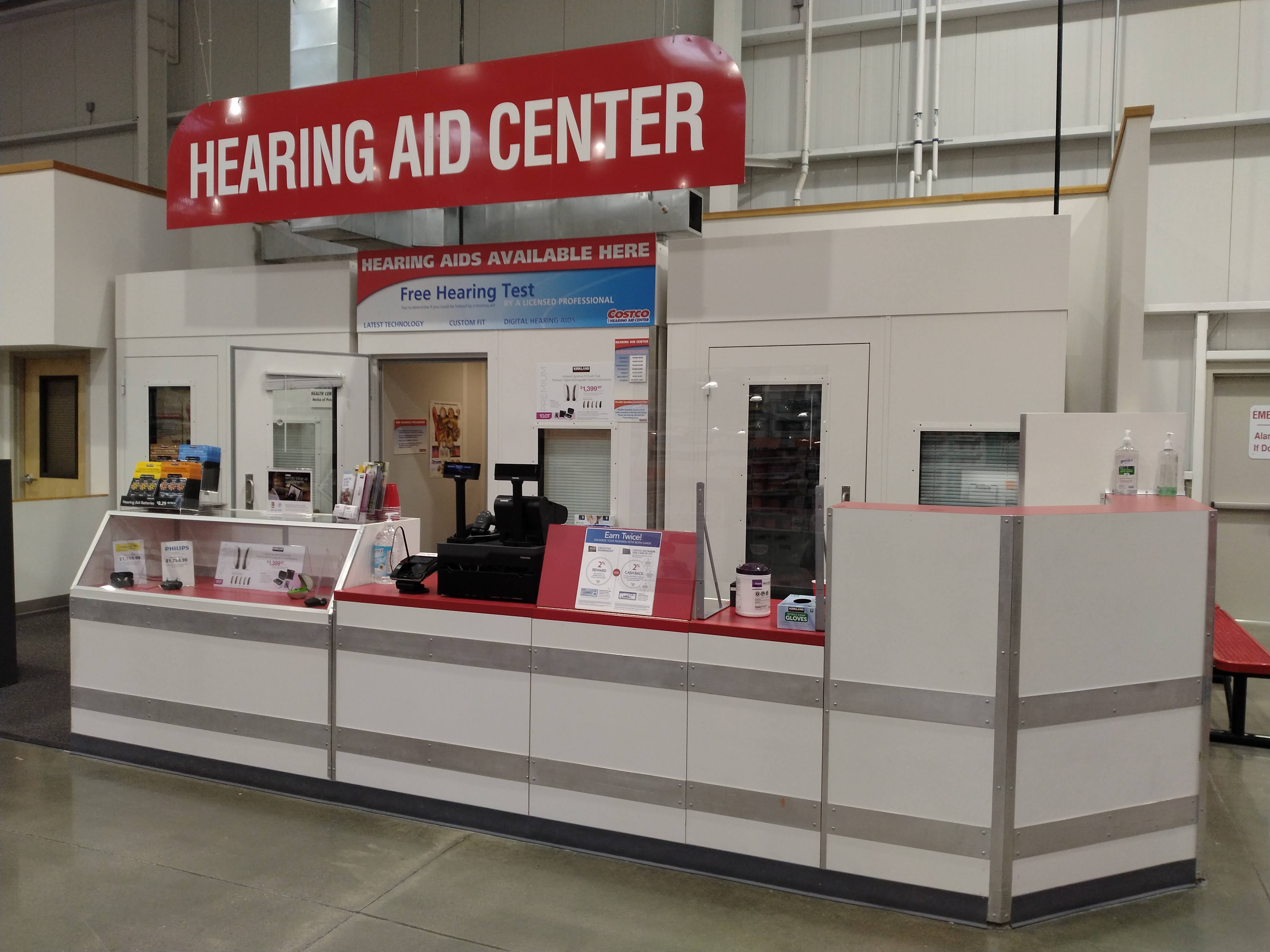
Audiologists and Hearing Clinics
Both OTC and prescription hearing aids can be purchased in person at audiology clinics. When purchasing prescription hearing aids, your audiologist will complete an audiogram to determine which frequencies and pitches are affected by your hearing loss. An audiologist can then make recommendations for hearing aids based on your hearing loss and fit you with a hearing aid that matches the shape and size of your ear. Prescription hearing aids also require an audiologist to access hearing aid software to program them to your specific hearing needs.
Some hearing aid companies like Audicus or Phonak have flagship stores or partner clinics that staff audiologists for testing and fitting. You can find these locations listed on the company’s websites. All flagship stores and partner clinics have hearing aid specialists on staff to test your hearing and order the best hearing aid for your needs. Once they arrive, you will return to the store or clinic to receive and test your new hearing aids.
ZipHearing is a discount retailer that works similarly. It offers discount prescription hearing aids when purchased through one of its partner clinics across the country. Once you provide your zip code and phone number to a phone representative, they connect you to one of their partner hearing clinics in your area to make an appointment with an audiologist. Their process works exactly the same as company flagship stores and partner clinics, except you’ll pay less because ZipHearing offers buys directly from the manufacturer to sell to you.
Buying Hearing Aids Using In-Home Services
For some, mobility is a barrier to receiving hearing care. If you need in-person hearing services but have limited transportation, there are services available that can come to you. Some local clinics offer in-home visits, but with an additional fee for transportation time. Call your local hearing clinic to see if they offer in-home services. Fees and availability depend on the clinic.
Online retailers like Yes Hearing offer cheaper in-home services. Similar to ZipHearing, they offer discount-price prescription hearing aids when purchased through a Yes Hearing specialist. However, Yes Hearing can perform in-home testing at no extra cost. To get started, you’ll have to book a free online consultation to speak with a specialist and find the right product based on your budget, lifestyle, and degree of hearing loss. Once you order your hearing aids, a Yes Hearing specialist will deliver it to help you fit and adjust the device according to your needs.
How We Research and Test Hearing Aids
Our hearing aid team hosted a research summit to test, score, and compare products on the market to determine which ones are the best. During the summit, our researchers performed in-depth testing on each hearing aid to score quality of features (like product durability and Bluetooth connectivity), user experience, pricing, customer service and support, and reputation. Check out our research methodology article for more details.
We interviewed expert audiologists Brad Ingrao, Au.D, with the Department of Veterans Affairs, and Sheri Mello, Au.D, with Raleigh Hearing and Tinnitus Center, about the hearing tests they use in their offices, different types of hearing loss, specific hearing aid models, and the industry as a whole.
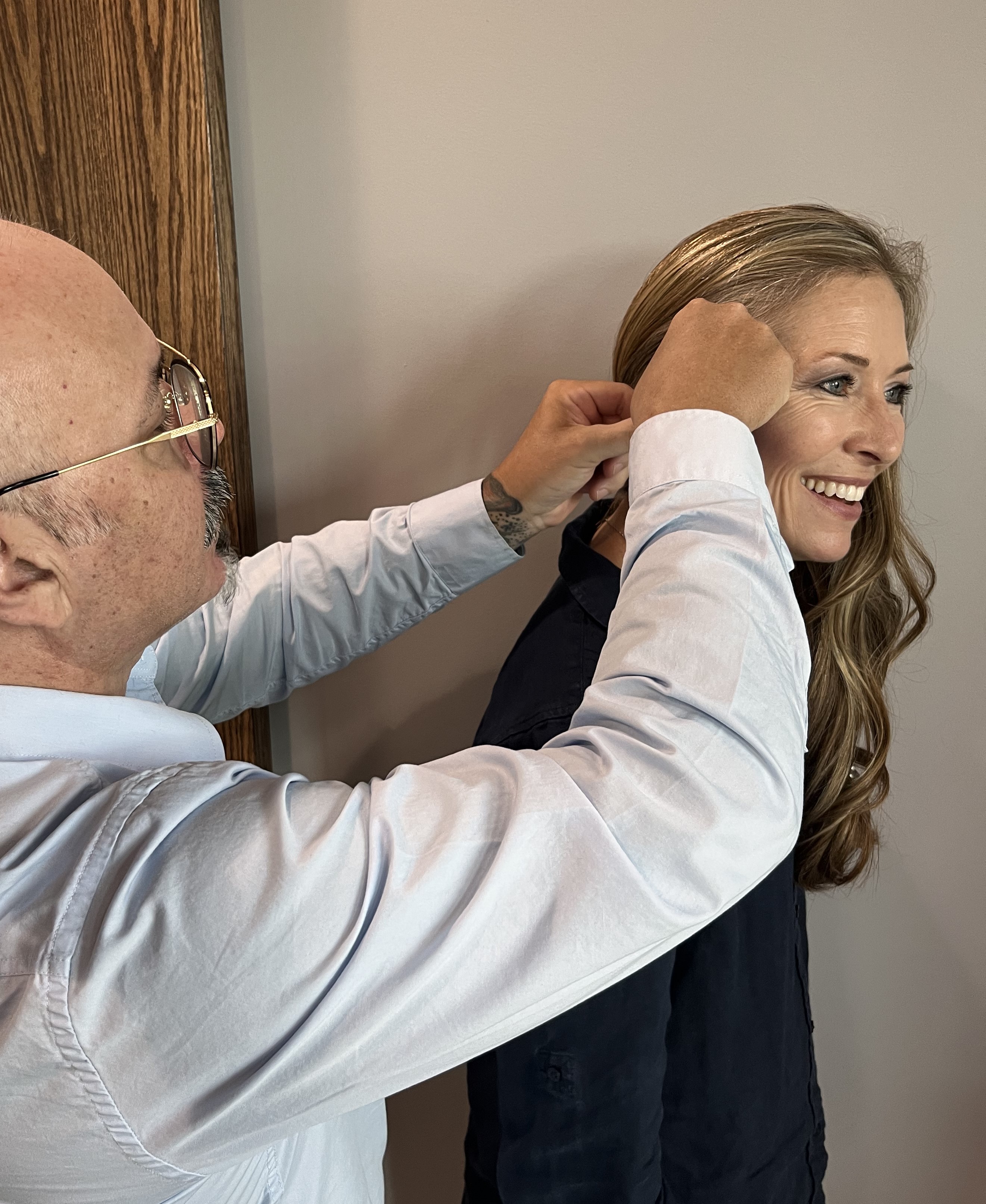
Next, our team conducted an online survey in August 2022 and held two focus groups—one for hearing aid users and the other for non-hearing aid users. The last step of our rigorous methodology process included the team physically testing 11 hearing aid models in our Raleigh, N.C. testing laboratory.
Overall, we’ve spent more than 4,000 hours researching hearing aid brands and consulting with audiologists to help you find the device that’s best for you.
Frequently Asked Questions
-
The Jabra Enhance Select 200 is our editor’s pick because it strikes the best balance between features and affordability by offering features typical of high-end prescription hearing aids in a less expensive direct-to-consumer package.
-
Completely-in-canal, or invisible, hearing aids are the most discreet on the market because they can’t be seen when worn.
-
Physical side effects from wearing hearing aids are uncommon. A 2019 study from the Journal of the American Academy of Audiology reported most negative side effects from hearing aids tend to be mild. If your device is not properly fitted, you may experience skin irritation, earwax buildup, and excessive itchiness in and around your ear. Some people also report headache or excessive feedback from their hearing aids.
-
Medicare Part A does not pay for hearing aids, exams, or fittings. Medicare Part B pays for hearing exams if you have a referral from your primary care physician. Medicare Advantage, known as Medicare Part C, may offer coverage for hearing aids. Check the details of your Medicare Advantage plan before purchasing hearing aids to be sure.
-
Yes. Hearing aids typically come with a trial period where you can try the hearing aids and return them without penalty for a limited time after purchase. Most trial periods are 30–100 days.
-
An audiologist at a hearing clinic can perform a hearing test for you. Some hearing aid manufacturers who sell online offer free hearing tests. However, a hearing test completed by a hearing professional will be more accurate and comprehensive than an online test.
-
Yes. Disposable-battery hearing aids typically use standard batteries in sizes 312, 13, or 10. Many hearing aids now have rechargeable batteries that vary in battery life on a single charge from 15 to more than 35 hours.
-
Adjusting to life with a new hearing device can take anywhere from a few days to a few months.
-
Yes. In-the-ear (ITE) hearing aids strike a good balance between a comfortable, discreet design and powerful features that improve your hearing. Because they are smaller than behind-the-ear hearing aids, however, they may be more difficult to place for people with hand dexterity issues.
-
Many people report that ITE hearing aids provide a comfortable fit inside the ear. It’s best to have these hearing aids fitted by a hearing professional.
-
Yes. Smaller hearing aids are typically better suited for people with mild to moderate levels of hearing loss. They won’t work well for severe to profound hearing loss because they aren’t big enough to contain the advanced technology needed to correct these hearing levels.
-
Mild to severe hearing loss can be treated with hearing aids. Complete hearing loss or nerve damage in the ears cannot be managed through hearing devices and may require treatment with a cochlear implant.
-
The average life of a hearing aid is three to seven years.
WRITTEN BY
Alex is a writer and speech-language pathologist, specialized in caring for older adults with communication disorders. She writes health and medicine content, with a focus on hearing aids and medical alert systems for AgingInPlace.org.
View AuthorMEDICALLY REVIEWED BY
Dr. Kupfer is an Audiologist and Hearing Aid Specialist in NYC, where she works with adults and older adults daily. In addition to diagnosing hearing loss, tinnitus and fitting cutting-edge hearing aids in her private practice, she serves as adjunct clinical faculty for the CUNY Audiology Doctoral Program.
View Reviewer- How Do Hearing Aids Work | Johns Hopkins Medicine
- Hearing Aids and Personal Sound Amplification Products: What to Know | FDA
- The Benefits of a Hearing Aid Telecoil (T-Coil) for Wireless Connectivity in a Public Venue | Dr. Cliff, Au.D.
- Hearing aids: How to choose the right one | Mayo Clinic
- Mini BTE Evaluation | UCI Audiology
- The Pros & Cons of Different Hearing Aid Types | Hearing Health Houston
- Negative Side Effects Associated with Hearing Aid Use in Adults with Hearing Loss | Journal of the American Academy of Audiology
- National Institute on Deafness and Other Communication Disorders
Do you want to cite this page? Use our ready-made cite template.

